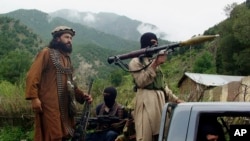Suicide bombers and gunmen penetrated a military base in northwestern Pakistan last week, killing eight soldiers.
It was just the latest in a string of deadly attacks to hit the South Asian country, where militant violence has surged in recent years.
But what was significant about the July 15 attack in the city of Bannu was the group that claimed responsibility -- Jaish Fursan-e Muhammad (JFM) -- a previously unknown militant outfit.
JFM is among several new militant groups that have announced their arrival on the crowded militant scene in Pakistan in recent months.
But experts believe the new actors are in fact fronts for existing groups, including the Tehrik-e Taliban Pakistan (TTP), the most lethal militant organization waging war against Islamabad.
JFM is a believed to be a front for Hafiz Gul Bahadar (HGB), a separate extremist group. The group is named after its leader, a former TTP commander.
Tehrik-e Jihad Pakistan (TJP), another militant group that announced its emergence last year, is considered by experts to be a front for the TTP. It marked its arrival with a spectacular attack on a key air base in the eastern province of Punjab in November.
Experts say the fronts have allowed the TTP and HGB -- which are coming under military pressure from Islamabad -- to maintain a position of plausible deniability.
"All these groups are either part of the TTP or Hafiz Gul Bahadar," said Mansur Mehsud, director of the FATA Research Center, an Islamabad-based nonprofit organization. "This is part of the TTP and HGB's strategy to create confusion."
'Using Different Names’
The TTP and HGB are both believed to be based in Afghanistan, where the Afghan Taliban seized power in 2021.
Experts say the Taliban takeover has emboldened and strengthened Pakistani militants. The withdrawal of foreign troops from Afghanistan has significantly reduced U.S. air strikes in the region, allowing militants to operate more freely.
TTP and HGB fighters have also obtained sophisticated weaponry, including U.S.-made firearms, left behind by international forces.
Pakistan has accused the Afghan Taliban of sheltering the TTP, with which it has close ideological and organizational ties.
Pakistan has used pressure tactics, observers say, to force the Afghan Taliban to sever ties with the TTP, including by expelling hundreds of thousands of Afghan refugees from Pakistan, shutting key border crossings, and blocking Afghan transit goods in recent years.
Islamabad has also conducted deadly cross-border attacks targeting alleged TTP hideouts in eastern Afghanistan.
The Afghan Taliban has tried to appease Pakistan by relocating TTP fighters away from the border with Pakistan to other areas of Afghanistan and brokering a year of peace talks between the Pakistani militants and Islamabad that broke down. But the Afghan militants have refused to expel the TTP from Afghanistan.
Each major TTP attack inside Pakistan has been followed by Islamabad issuing condemnations and summoning the Afghan Taliban's ambassador in protest.
"The [Pakistani] Taliban are strong, but also under pressure," said Muhammad Amir Rana, an Islamabad-based security and political analyst. "They are using different names as part of their strategy and also to avoid pressure."
Mehsud of the FATA Research Center said the "TTP sometimes deliberately avoids large-scale attacks just to avoid pressure" from the Afghan Taliban, which he said has tried to convince its Pakistani ally to rein in its attacks.
'Security Situation Is Very Bad'
The TTP and HGB as well as their affiliates have concentrated most of their attacks in Khyber Pakhtunkhwa, the northwestern province along the border with Afghanistan that has long been a hotbed of militancy.
Several other militant groups that have attracted less headlines have also recently emerged in the region. They include Lashkar-e Khorasan, a militant group believed to be a front for the TTP. The other is the Shaheen Group, which is considered a front for the HGB. Both groups have claimed attacks in Khyber Pakhtunkhwa in recent months.
Pakistan earlier this year said the military would launch a new offensive to root out militants in the northwest, without offering details.
The planned military operation has been fiercely opposed by locals in Khyber Pakhtunkhwa, the scene of numerous offensives that have killed thousands and uprooted millions of civilians in the past.
Thousands of people rallied in Bannu on July 19 to call for an end to military operations in the region. The demonstration turned violent and security forces fired on protesters, killing one person. Since then, thousands of people have been participating in a sit-in protest in Bannu.
Rana, the Islamabad-based analyst, says Pakistan faces no good choices in its battle to curb the soaring number of militant attacks in the country.
If it launches a deadly military assault, it will attract the wrath of the public. If it targets alleged TTP strongholds inside Afghanistan, it will further escalate tensions with the Afghan Taliban, he says.
"The security situation is very bad," Rana said. "This is the peak of it now."


